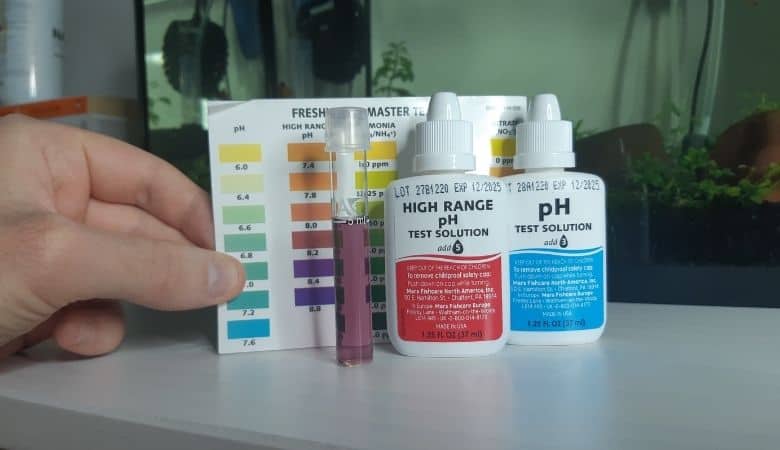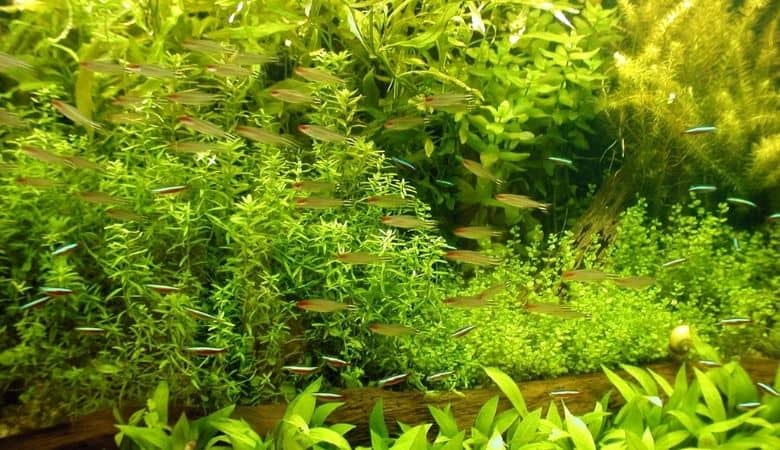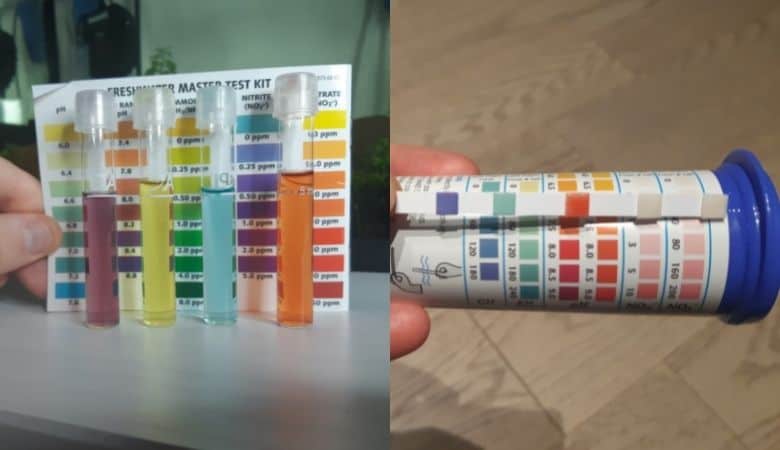The pH of a planted aquarium is important and can be determined by the type of fish, substrate, water hardness, and plant material. One way to change your planted aquarium’s pH is with natural additives like peat or limestone chips.
A pH between 6.0 to 7.5 will allow you to successfully grow the majority of aquatic plants. However, many less demanding plants grow well with a pH between 7.5 to 8.5, such as water wisteria, hygrophila polysperma and staurogyne repens.
This blog post will explain everything you need to know about pH and how it can help you maintain a thriving planted tank ecosystem.

Contents
- 1 The pH scale and how it works
- 2 What the ideal pH is for a planted aquarium?
- 3 Why you should keep your tank’s pH at an optimum level
- 4 Measure your aquarium pH using liquid test kits or test strips
- 5 How to test your tap water pH
- 6 Why your pH swings and how to fix it
- 7 Can you adjust your aquarium’s pH levels?
- 8 How to safely raise your aquarium pH
- 9 How to safely lower your aquarium’s pH
- 10 What aquarium plants do well in high pH?
The pH scale and how it works
pH, also referred to as the “potential of hydrogen,” is a process used for determining the concentration of hydrogen ions in an aqueous solution.
The pH scale ranges from 0 to 14, although there are a few chemicals that have values outside of this range.
A pH of 7.0 is considered to be neutral. But for more practical purposes, a neutral aquarium would have a pH between 6.0 and 8.0.
A pH below 7 has a higher concentration of hydrogen ions and is considered to be acidic, while a pH above 7 is considered basic.
pH is measured using a logarithmic scale
The ph scale is a logarithmic measurement which means that each unit on the scale is equal to ten times more than the previous.
For example, a pH of 6.0 is ten times more acidic than a pH of 7.0 and 100 times more acidic than a pH of 8.0.
Who created the pH scale?
It was originally developed by Danish biochemist Søren Peder Lauritz Sørensen in 1909 as he studied proteins with his assistant Hilde Levi, who would become his wife and lifelong collaborator.
What is different about water with different pH values?
Water molecules are made up of two hydrogen protons and one oxygen electron (H2O).
Under certain circumstances, the hydrogen protons can break off, creating hydrogen ions (H+) and hydroxide ions (OH-). The more protons (H+) that have been released into the water, the lower the pH number is.
This is considered to be an acid and will have a pH value below 7.
This is because the concentration of positively charged ions is greater than the concentration of negatively charged ions.
If there are an equal amount of both ions, the liquid is considered to be neutral and will have a pH of 7. If there are more electrons, the liquid will be basic and will have a pH greater than 7.
What the ideal pH is for a planted aquarium?
A pH of between 6.0 to 7.5 is considered ideal for a planted aquarium. This is considered to be fairly neutral aquarium water and is the range where most aquatic plants thrive.
However, many live plants can thrive in acidic water or basic water as well.

The key to growing planted aquariums successfully is to choose plants that are suitable for the pH of your tap water.
If you have very soft tap water, consider choosing plants and fish species that thrive in those water parameters.
Why you should keep your tank’s pH at an optimum level
It’s important to maintain a stable pH value in your aquarium to promote healthy plant growth and to minimize fish stress.
pH affects how macronutrients and other materials dissolve into water. Once dissolved, these materials can be absorbed more easily by plants. Sensitive plants will struggle to grow at a pH that does not allow certain macronutrients to become water-soluble.
This applies to fish as well.
At the extreme ends of the pH scale, certain toxins can dissolve into water. Fish may absorb these toxins into their bodies, causing harm.
At certain points on the pH scale, phosphorus, potassium, magnesium and other plant macronutrients are no longer soluble. This causes deficiencies because plants are unable to absorb these important nutrients, which are necessary for root growth and other developmental functions.
By maintaining a stable pH in your fish tank, you ensure that the environment is ideal for both long-term health and to keep the plants from experiencing nutrient deficiencies. These deficiencies can result in slower growth or even death.
And of course, water with varying pH levels will affect the type of fish you can successfully grow in your aquariums.
For example, most freshwater aquarium fish species prefer fairly neutral pH levels so toxins, such as heavy metals, do not leach into their bodies – like it would in acidic water where certain heavy metals become soluble.
Other species thrive in more basic water conditions with alkaline environments, such as African cichlids and livebearers.
Measure your aquarium pH using liquid test kits or test strips
There are a few methods for measuring your water chemistry. The easiest and quickest method is by using test strips, which you dip and swirl into your tank water for a few seconds.
While this method is quick, I don’t find that it’s as accurate. Also, I find the test strips difficult to read at times due to the texture of the testing pad and the small size.

Another method would be using API’s freshwater test kit or another brand of liquid water parameter tests.
With this method, you must fill a glass vial with 5ml of aquarium water and add 5 drops of either the “low end” or “high end” pH drops, depending what range your tank water’s pH level falls within.
You then cap the test tube and invert it a few times to mix the solution.
The liquid will then change to a color that you can match to the provided pH color scale.
How to test your tap water pH
First, fill a bucket with at least 1 gallon of water from your kitchen sink, bathtub, or wherever you plan on conducting water changes.
Add an airstone and wait 24-48 hours before conducting a test. Your tap water contains CO2, which will cause your test to read a lower pH than it would after this CO2 is released.
After 24-48 hours with an airstone and exposure to air, your tap water will have exchanged enough gas to provide an accurate water test reading.
You can now follow the instructions on your liquid test kit or test strips to measure your tap water parameters.
Why your pH swings and how to fix it
When your pH levels fluctuate it means the concentration of hydrogen (H+) ions and hydroxide (OH-) ions are changing.
pH swings can be prevented by increasing the carbonate hardness, or KH, of your aquarium water.
KH is a water parameter that measures the concentration of carbonate and bicarbonate ions in your fish tank, which are compounds that buffer pH swings.
These compounds soak up excess hydrogen ions when the pH drops, and release hydrogen ions when the pH rises. This causes the pH to remain the same, which is important in preventing fish stress and maintaining healthy aquatic plants.
A KH of 89 ppm, or 5 dKH, will be adequate for most freshwater aquariums. You can measure KH using similar API liquid drop tests as with pH.
Aquariums with a high buffering capacity, or high KH value, are commonly referred to as having alkaline water. Alkalinity refers to the total buffering capacity of your fish tank.
Can you adjust your aquarium’s pH levels?
You can change your water’s pH levels through careful manipulation of the tank’s general hardness (GH), carbonate hardness (KH), and water temperature.
It’s generally not advised to change your water’s pH unless you have experience. This is because fish and plants are sensitive to changes in water chemistry.
Importantly, because pH is measured using a logarithmic scale, it means that a pH of 6.0 is 1,000 times more acidic than apH of 8.0.
For example, most types of freshwater shrimp will not survive a sudden drop in pH level because they do not possess alkaline reserves like certain other species of fish.
How to safely raise your aquarium pH
Increase your aquarium’s aeration with air stones
Aerating an aquarium will increase pH levels if there is a buildup of CO2.
The reason for this is because prolonged CO2 build-up will convert into carbonic acid, which will lower your tank’s pH unless you have a high enough KH to buffer pH changes.
An aquarium with poor circulation and infrequent water changes may not have enough air exchange to remove the CO2 from the tank naturally, which is why aeration might be a good solution.
Add crushed coral
Crushed coral is a rock that has a high pH. If the surface of the crushed coral is exposed to water for a prolonged period, it can slowly dissolve and increase the alkalinity.
The bottom line:
Crushed coral works to increase an aquarium’s pH by providing calcium carbonate (which dissolves quickly), but one needs to make sure that their tank is cycled before adding any new material like this because it will disrupt beneficial bacteria colonies which are crucial in processing waste products.
We suggest waiting until your tank undergoes its cycle before adding this type of additive. It’s also recommended that you remove your fish from your tank while attempting to change your aquarium’s pH as it will cause stress.
How to safely lower your aquarium’s pH
Add an Indian almond leaf
Indian almond leaves have a natural chemical called tannins in them which lower the pH because of their acidifying properties.
They also lessen buffer capacity, so over time, constant usage will necessitate the addition of other substances to control or maintain the desired pH level.
Dilute your tap water with reverse-osmosis (RO) water
RO water is produced using a process called reverse osmosis, by which water is passed through a semi-permeable membrane that filters out nearly all minerals and impurities.
The result is water that typically has a pH of 7.0, a GH of 0 and a KH of 0.
Some aquarists choose to dilute their hard tap water with RO water to decrease the overall pH, GH and KH.
This can be a good method for achieving desired water parameters. However, the use of diluted RO water becomes complicated when performing water changes because you need to make sure you maintain consistent water chemistry when you replace the removed tank water.
Failure to do so accurately will cause fish stress, which can lead to discomfort and disease.
What aquarium plants do well in high pH?
Most aquatic plants grow well in a neutral or slightly acidic water, but here are some that are particularly well suited to higher pH levels:
- Hygrophilia difformis (water wisteria)
- Cryptocoryne lucens
- Staurogyne repens
- Helantium tenellum green
- Anubias species
In my experience, water wisteria is an excellent option for high pH because it has a low demand for nutrients, light and carbon dioxide. It grows incredibly quickly in my 8.2 pH low-tech tank and can grow both rooted or floating.
Plus, it doesn’t look like a weed – which is common among many of the high-pH aquatic plants.

